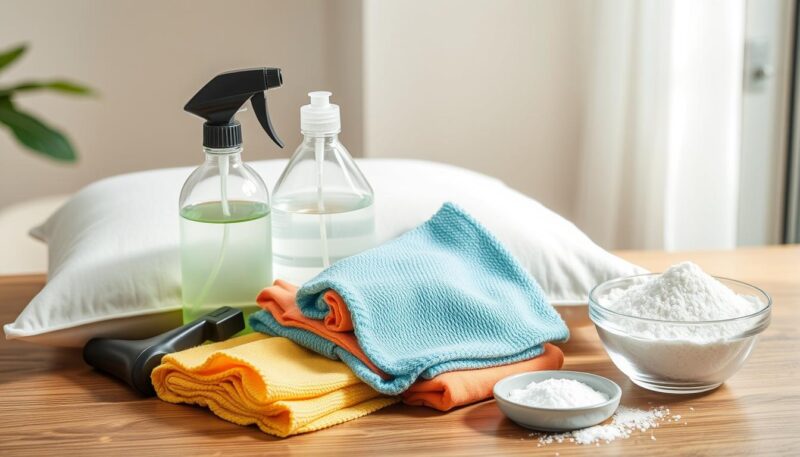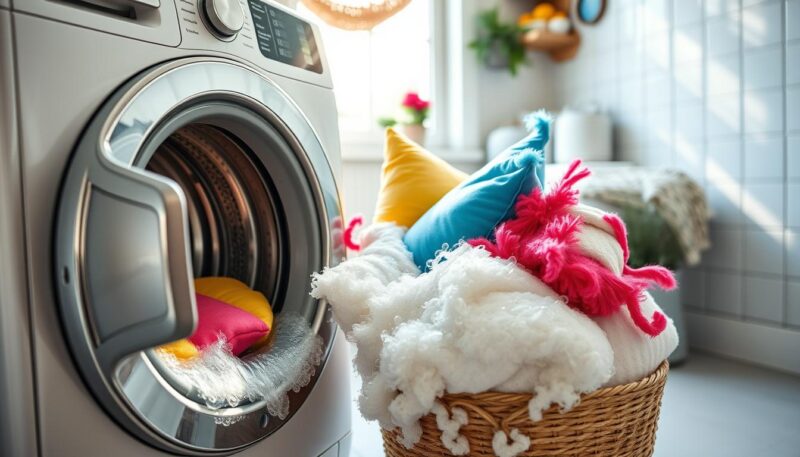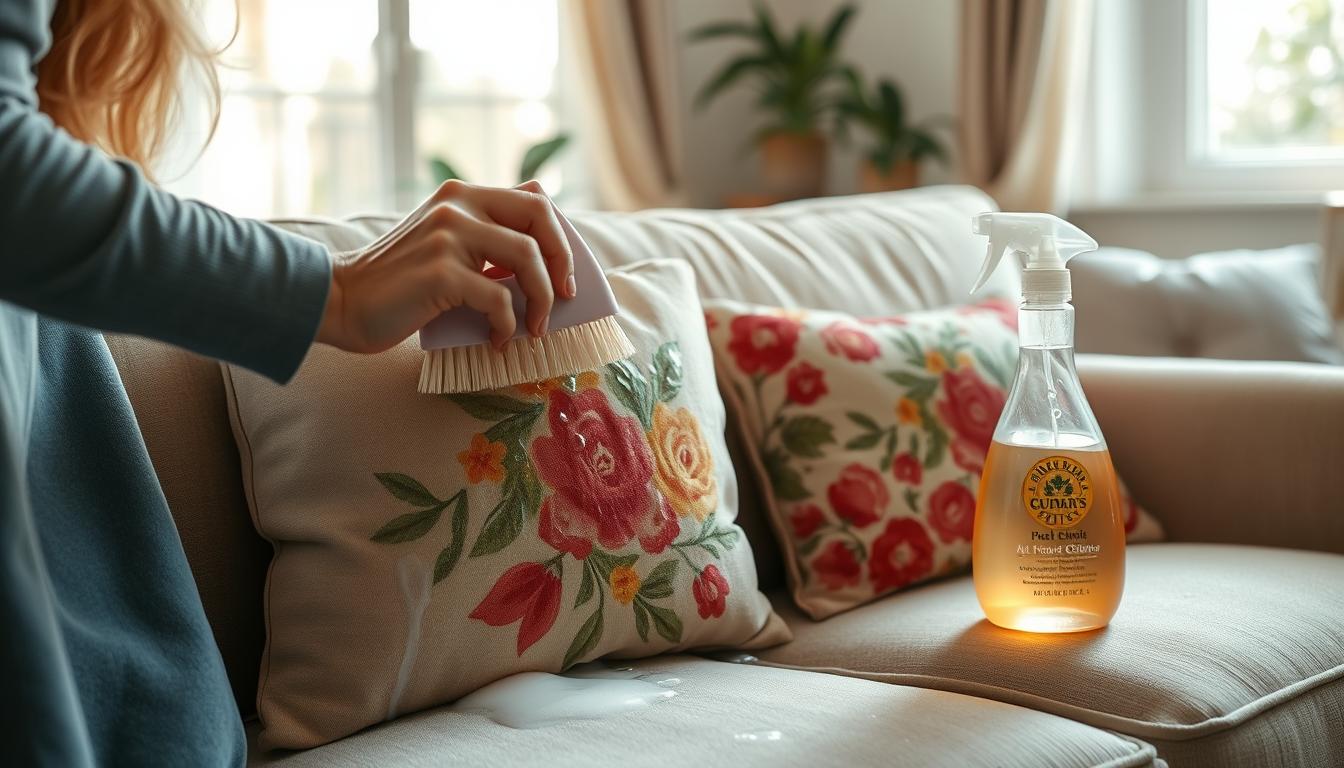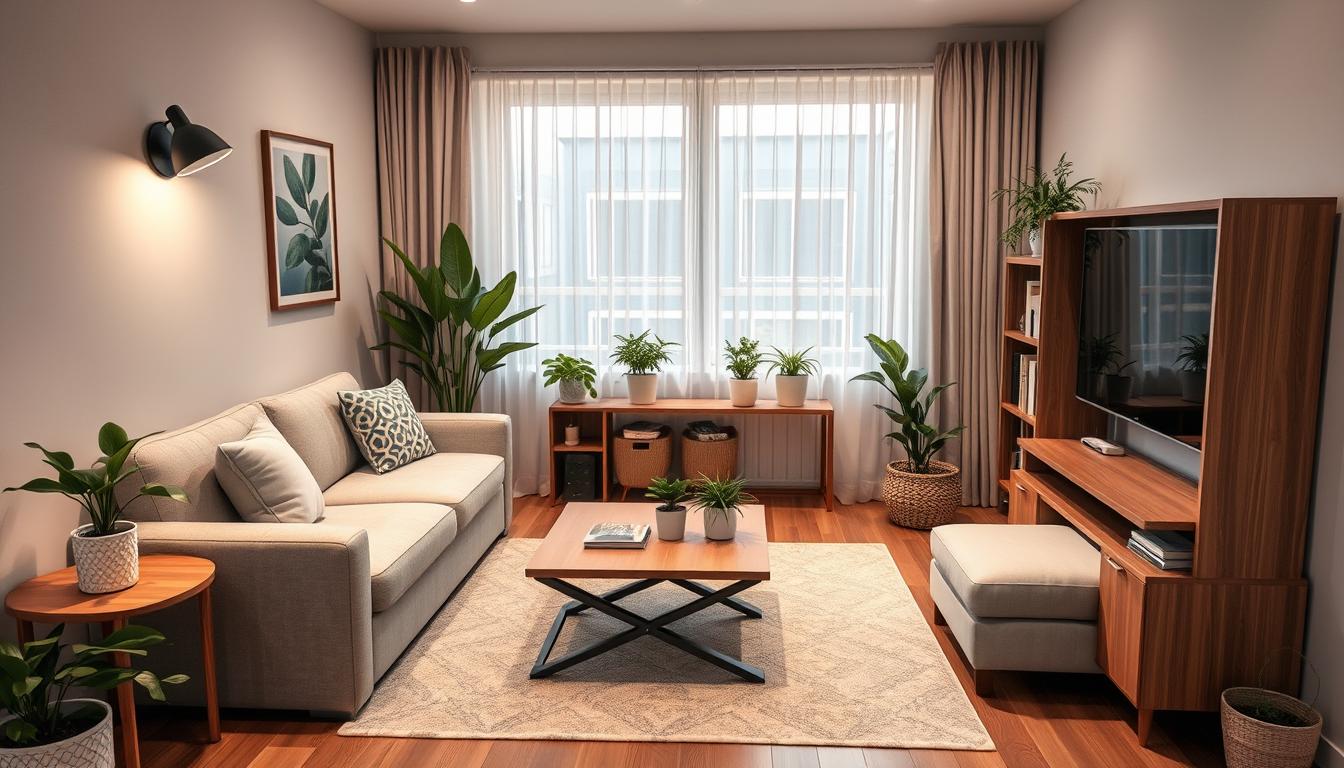Your dining room chair cushions likely take a beating every day. With the right techniques and a little elbow grease, you can make them look as good as new. After all, you may have spent a fortune on your dining room chairs, especially if you’re using velvet chairs with cushions to match. Regular cleaning can keep your cushions fresh and extend their lifespan. It also makes them look great for longer. Try to clean your cushions every two months to keep them fresh.
Immediate treatment of spills can prevent stains from setting in, maintaining the appearance of the cushions. Rotating dining chair cushions every 6 months can distribute wear evenly and prolong their usability. Professional cleaning services may be necessary for extremely stubborn stains, heavily soiled antique upholstery, or severely matted cushion fillings.
Key Takeaways
- Regular cleaning every two months can help keep dining chair cushions fresh and extend their lifespan.
- Immediate treatment of spills can prevent stains from setting in, maintaining the appearance of the cushions.
- Rotating dining chair cushions every 6 months can distribute wear evenly and prolong their usability.
- Professional cleaning services may be necessary for extremely stubborn stains or heavily soiled upholstery.
- Using natural cleaning solutions can provide effective and eco-friendly alternatives for cleaning delicate fabrics.
Understanding the Importance of Regular Cushion Cleaning
Maintaining the cleanliness and longevity of your dining chair cushions is essential for creating a comfortable and inviting atmosphere in your home. Over time, these cushions can accumulate built-up dirt and debris, stains and odors, and even experience material deterioration and mold growth if not properly cared for.
Built-up Dirt and Debris
Food crumbs, dust, and pet hair can easily accumulate on your dining chair cushions, leading to a dingy and unpleasant appearance. This buildup of dirt and debris can have an abrasive effect on the fabric, accelerating the wear and tear of your cushions.
Stains and Odors
Spills and stains from drinks, sauces, and oils can easily sink into the fabric of your cushions, creating unsightly blemishes. These stains, combined with the lingering smells of food and pet dander, can result in foul odors that can be difficult to remove if not addressed promptly.
Material Deterioration and Mold Growth
The moisture retained in dirt and spills can promote the growth of mold, which can not only damage your cushions but also pose a health risk to you and your family. Additionally, the abrasive nature of built-up dirt can lead to premature wear and tear of the cushion materials, shortening their lifespan.
Regular cleaning of your dining chair cushions is essential for maintaining their appearance, preserving their condition, and extending their usable lifespan. By addressing built-up dirt and debris, stains and odors, and preventing material deterioration and mold growth, you can ensure your cushions remain comfortable, fresh, and inviting for years to come.
Preparing for the Cushion Cleaning Process
Before you dive into cleaning your seat cushions, it’s essential to gather the necessary supplies. This will ensure a thorough and effective cleaning process. Start by gathering a vacuum cleaner, a soft-bristled brush, mild laundry detergent, cleaning cloths, a bucket or large basin, and a stain remover (if needed).
Next, examine the tag on your cushions to determine the specific material. This information will guide your cleaning approach. Cushions made of cotton, polyester, or acrylic can often be safely cleaned in a washing machine using cold water and the most delicate cycle. However, cushions that resemble pillows and need to retain their structure may fare better with hand washing or spot cleaning.
Inspecting Cushion Materials
- Check the cushion tag for material details.
- Identify if the cushion can be machine washed or requires hand washing.
- Determine if the cushion needs to maintain its shape and structure.
- Inspect the cushion for any visible stains or damage.
By taking the time to prepare and inspect your cushions, you’ll be able to tackle the cleaning process with confidence, ensuring your seat cushions look and feel their best.

Effective Cleaning Methods for Seat Cushions
Maintaining the cleanliness and quality of your seat cushions is crucial for preserving their appearance and longevity. Whether you have machine-washable cushion covers or delicate fabrics, there are effective cleaning methods to consider. Let’s explore the best ways to tackle machine washing cushion covers and hand washing delicate cushions.
Machine Washing Removable Covers
If your seat cushions have removable covers, machine washing can be a convenient and effective cleaning solution. Start by carefully removing the covers from the cushions. Fill a washing machine with warm (not hot) water and add a small amount of mild laundry detergent. Gently place the cushion covers in the machine and let them soak for 15-20 minutes. This allows the detergent to penetrate and loosen any built-up dirt and debris. Then, run the machine on a gentle cycle to ensure your cushion covers are cleaned effectively without damaging the fabric.
Hand Washing Delicate Cushions
For cushions with non-removable covers or delicate fabrics, hand washing may be the better option to maintain their cleaning effectiveness and preserve cushion quality. Fill a large basin or bucket with warm (not hot) water and add a small amount of mild detergent or soap. Gently submerge the cushion and use a soft sponge or cloth to lightly scrub the surface, paying extra attention to any stains or odors. Rinse the cushion thoroughly with clean water to remove all traces of soap, and pat it dry with a towel.
Regardless of the cleaning method, it’s essential to handle your cushions with care to avoid damaging the fabric or causing material deterioration. Always follow the manufacturer’s instructions and consider rotating your cushions every few months to distribute wear evenly.
| Cleaning Method | Advantages | Considerations |
|---|---|---|
| Machine Washing Removable Covers |
|
|
| Hand Washing Delicate Cushions |
|
|

By following these effective cleaning methods, you can keep your seat cushions looking and feeling their best, while also preventing mold growth and prolonging the life of your furniture. Remember, regular maintenance is key to maintaining the cleaning effectiveness and preserving cushion quality for years to come.
How to Clean Seat Cushions
Maintaining the cleanliness and quality of your seat cushions is essential for a comfortable and well-kept home. Whether you have dining chair cushions, patio furniture cushions, or any other type of fabric-covered cushions, a comprehensive cushion cleaning process can help extend their lifespan and keep them looking their best. Follow this step-by-step cleaning guide to ensure your cushions stay fresh and inviting.
- Vacuum Thoroughly: Begin by thoroughly vacuuming the cushions to remove any loose dirt, debris, or pet hair. This crucial first step helps prepare the cushions for deeper cleaning.
- Pretreat Stains: Identify any visible stains on the cushions and pretreat them with a small amount of laundry detergent or a fabric-safe stain remover. Allow the solution to sit for a few minutes before proceeding to the next step.
- Hand Wash or Machine Wash: For removable cushion covers, you can machine wash them on a gentle cycle using a mild detergent. For non-removable cushions, hand wash them using a soft-bristled brush and a gentle, fabric-safe cleaning solution.
- Air Dry Completely: After washing, allow the cushion covers or non-removable cushions to air dry thoroughly. Lay the covers flat or stand them upright to ensure even drying. Blot any excess moisture from non-removable cushions before air drying.
By following this comprehensive cushion cleaning process, you can maintain the quality and appearance of your seat cushions, ensuring a comfortable and inviting seating experience in your home.
“Regular cleaning is the key to keeping your seat cushions looking their best and extending their lifespan.”
Drying and Fluffing Cushions for Optimal Shape
Once you’ve cleaned your seat cushions, it’s time to focus on proper drying techniques to maintain their shape and comfort. The way you dry your cushions can make a big difference in how they look and feel.
Hang Drying vs. Machine Drying
For removable cushion covers, lay them flat or stand them upright to air dry. This gentle method can take 1-2 hours or longer, but it helps preserve the cushion’s fabric and prevents fading from direct sunlight. For non-removable cushions, be sure to blot any excess moisture with a towel before allowing them to air dry completely.
Redistributing Cushion Filling
Regularly fluffing and redistributing the cushion filling is essential for maintaining their shape and comfort. Over time, the filling can shift and clump, leading to uneven support. Gently poke and prod the cushions to evenly redistribute the stuffing, whether it’s foam, down, or synthetic fibers. This simple task can extend the lifespan of your cushions and keep them looking and feeling their best.
By following proper drying techniques and regularly fluffing your cushions, you can ensure they retain their optimal shape and continue providing the comfort you expect from your favorite seating areas.
Alternative Cleaning Solutions for Fabric Cushions
For delicate fabrics or a chemical-free approach, try these natural cleaning solutions to keep your fabric cushions looking their best:
Baking Soda and Vinegar Mixtures
Baking soda creates a gentle abrasive solution that’s great for lifting dirt. Mix it with water to form a paste, then apply and scrub gently before rinsing it clean. White vinegar has antimicrobial properties to kill bacteria and odors. Mix equal parts vinegar and water to wipe down your cushions.
Hydrogen Peroxide and Club Soda
Hydrogen peroxide is an effective bleaching agent for whitening discolored fabrics. Dilute it with water before applying and rinsing your dining chair cushions. The carbonation in club soda can also help lift stubborn stains. Pour it directly onto the stain, let it fizz, then blot it dry.
These chemical-free cushion cleaning methods are gentle yet effective, allowing you to freshen up your fabric furnishings without harsh chemicals. Remember to always spot test any new cleaning solution on a small, inconspicuous area first.
When to Seek Professional Cushion Cleaning Services
If you’ve exhausted your efforts to clean your seat cushions, it may be time to call in the experts. Professional cleaning services can tackle the toughest cleaning challenges, from extremely stubborn stains that require specialized chemical treatments or steam cleaning to severely contaminated cushions that need thorough sanitizing. They can also assist with heavily soiled antique or delicate upholstered furniture, as well as severely matted or deteriorated cushion fillings that may require replacement.
Professional upholstery cleaning services are highly recommended for homeowners dealing with water damage, smoking-related stains, or pet urine contamination on their cushions. These experts have the knowledge and equipment to effectively clean and restore your cushions, helping to extend their lifespan and prevent the need for premature replacement.
Don’t hesitate to seek professional help when your cushions have reached a point where your own cleaning efforts are no longer effective. The investment in professional services can renew the appearance and condition of your cushions, allowing you to enjoy your furniture for longer and maintain a comfortable, hygienic living space.
Source Links
- https://www.modernloftinteriors.com/blogs/creative-loft-blog/how-to-clean-dining-room-chair-cushions-a-step-by-step-guide-for-spotless-seating?srsltid=AfmBOorqz7spiu0M_z_7B-3RIXsFgn4il_-JveB_9l6zmiRw8ZTu8ztO
- https://ask.metafilter.com/375719/How-to-best-wash-couch-seat-cushions-cloth
- https://www.bhg.com/how-to-clean-couch-cushions-7095970
- https://www.southernliving.com/how-to-clean-couch-cushions-8546356
- https://www.jenniferfurniture.com/blogs/furniture-buying-guide/how-to-clean-your-sofa-cushions?srsltid=AfmBOor7TXrd4usbbdpjfxnmlhPuFIHEKo24Km_1cWpddYGrGNGcg0wu
- https://www.architecturaldigest.com/story/how-to-clean-outdoor-cushions
- https://www.jenniferfurniture.com/blogs/furniture-buying-guide/how-to-clean-your-sofa-cushions?srsltid=AfmBOop9Z1_fs7DFnDv7njesjRRrA1iPzV88sdTTE-IIsuGlLM_LyZ6N
- https://www.carpetcleaninglymm.co.uk/post/how-to-clean-couch-pillows-including-the-foam-cushion
- https://www.lowes.com/n/how-to/clean-patio-cushions-furniture
- https://www.modernloftinteriors.com/blogs/creative-loft-blog/how-to-clean-dining-room-chair-cushions-a-step-by-step-guide-for-spotless-seating?srsltid=AfmBOopPH0skxxS8Gxykq86dfBd-7Y9XQ5aI2zF1dNlxA71b3uGJ_SSa
- http://smallishhome.com/how-to-easily-clean-outdoor-cushions-so-they-last-for-years/
- https://fj-outdoors.com/blogs/guide/sit-in-style-mastering-the-art-of-cleaning-and-maintaining-seat-cushions
- https://www.modernloftinteriors.com/blogs/creative-loft-blog/how-to-clean-dining-room-chair-cushions-a-step-by-step-guide-for-spotless-seating?srsltid=AfmBOoo41hMbv0jYmCwjOajlTFXq0DO3Y_vlAYMCZ8jz5kOVRxCas-88
- https://fj-outdoors.com/blogs/guide/the-ultimate-guide-how-to-wash-chair-cushions-like-a-pro
- https://starfurniture.com/blog/its-more-than-fluff-how-to-care-for-sofa-cushions-the-right-way/
- https://www.modernloftinteriors.com/blogs/creative-loft-blog/how-to-clean-dining-room-chair-cushions-a-step-by-step-guide-for-spotless-seating
- https://www.couchhaus.com/blogs/featured/how-to-maintain-feather-filled-couches
- https://www.modernloftinteriors.com/blogs/creative-loft-blog/how-to-clean-dining-room-chair-cushions-a-step-by-step-guide-for-spotless-seating?srsltid=AfmBOorOvTYZouAAzAhae3P9SGw_C1ps1Bvb6CaZ8AtxS-mX9exLCG0p
- https://diynatural.com/clean-upholstery/
- https://rescuemytimecleaningservice.com/house-cleaning-tips/diy-how-to-make-your-own-homemade-upholstery-cleaner/
- https://nextdaycleaning.com/upholstery-cleaning-checklist/
- https://www.shadesofblueinteriors.com/my-fav-upholstery-cleaning-tips/
- https://www.coit.com/blog/general-home-cleaning/how-often-should-i-clean-my-couch




